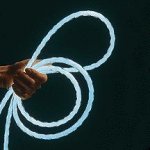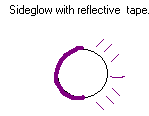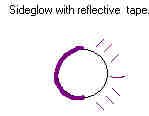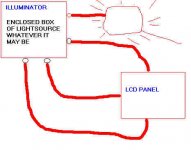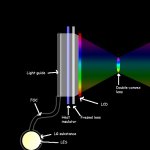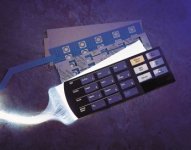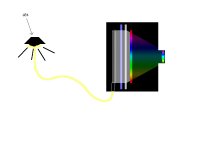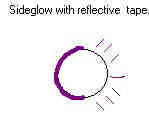Round to thin conversion? I'm not exactly sure what that means.
Yeah, Metal Halides are nice and all, but if I need to buy a $30 lens, a $50 ballast, a $30 bulb, and another $20-30 lens, not to mention the reflector, I'd almost rather just buy a couple $15 500 Watt work-lights with $6 replacement bulbs, remove the housing, slap them end-to-end, and use a $8 piece of sheet-aluminum bent into an ellipse and feed that into the end of my expensive $200 1024x768 LCD panel. (or my even cheaper $60 320x240 automobile video panel). That's definately a sub-$100 bright decent-quality video projector.
I think I'm more on the budget-oriented side.
Also, do you think that those optics would be pretty hard to line up in your case? The only thing that matters with the elliptical reflector setup is the accuracy of the bend for the ellipse, but you could trace wooden (would it get too hot on the reflector for wood?) braces and bend the sheet metal into the ellipse shape that way.
I suppose accuracy is available in both ways... the next question comes is if one way would produce better results than the other, then weigh if the results are worth the cost difference?
Any input? I don't really know what the quality difference would be with regards to both of them.
--Clint
Yeah, Metal Halides are nice and all, but if I need to buy a $30 lens, a $50 ballast, a $30 bulb, and another $20-30 lens, not to mention the reflector, I'd almost rather just buy a couple $15 500 Watt work-lights with $6 replacement bulbs, remove the housing, slap them end-to-end, and use a $8 piece of sheet-aluminum bent into an ellipse and feed that into the end of my expensive $200 1024x768 LCD panel. (or my even cheaper $60 320x240 automobile video panel). That's definately a sub-$100 bright decent-quality video projector.
I think I'm more on the budget-oriented side.
Also, do you think that those optics would be pretty hard to line up in your case? The only thing that matters with the elliptical reflector setup is the accuracy of the bend for the ellipse, but you could trace wooden (would it get too hot on the reflector for wood?) braces and bend the sheet metal into the ellipse shape that way.
I suppose accuracy is available in both ways... the next question comes is if one way would produce better results than the other, then weigh if the results are worth the cost difference?
Any input? I don't really know what the quality difference would be with regards to both of them.
--Clint
remp said:
We are getting much closer now to being able to power up an LCD via the backlight position. And its only been a few days.
A few days? Verbose Mustafa and I have been discussing retrofitting backlights for at least two weeks now. 😛 (granted, we were talking about using high-emittance LED's to replace the CCFT, but... well... yeah)
Okay I'm done now.
Step out of the light....
And look at the BIG picture 😉 There is some great thought process going on here, I think there is enough supposition and good fact based theory here that an answer is actually not far off. If we can stay "focussed" I think WE CAN come up with a truly "new way" of lighting a PJ! And when we do.....the first one to the patent office needs to come back here and give every contributor a free "cold projector" for the assist. 😉
I vote remp get's the first freebie. Remp, I used to consider myself a "research king"....next to you I might be lucky to get the title "research baron ...maybe even court jester" my hat is off to you! Your dedication to advancement of new ideas is astounding, as such I have a question... how do you get the time to do all the digging you do? Some of the info you find is soo obscure it must take hours of wading through technical files to get the relevant stuff you post.
This forum is a "think tank" of such capacity I doubt that there is "stumper" of a problem we can't eventually solve!
zardoz
And look at the BIG picture 😉 There is some great thought process going on here, I think there is enough supposition and good fact based theory here that an answer is actually not far off. If we can stay "focussed" I think WE CAN come up with a truly "new way" of lighting a PJ! And when we do.....the first one to the patent office needs to come back here and give every contributor a free "cold projector" for the assist. 😉
I vote remp get's the first freebie. Remp, I used to consider myself a "research king"....next to you I might be lucky to get the title "research baron ...maybe even court jester" my hat is off to you! Your dedication to advancement of new ideas is astounding, as such I have a question... how do you get the time to do all the digging you do? Some of the info you find is soo obscure it must take hours of wading through technical files to get the relevant stuff you post.
This forum is a "think tank" of such capacity I doubt that there is "stumper" of a problem we can't eventually solve!
zardoz
remp said:
Since you cannot find this info anywhere else on the internet we just have to be the first guys.
That's exactly the part that's scaring me. Is it bad to wake up in the morning knowing that your roommate is going to be gone for the next 3 weeks, and you *REALLY* want to dismantle his laptop to try and retrofit the backlight optics? 🙂 🙂 🙂
The thing is, it's my laptop, he just borrows it from me to type papers on and check e-mail, so it's "his" computer so that he doesn't jump on my good box all the time.
Ah, the endless moral dilemmas of college life. 🙂
Cheers!
--Clint
Fiber Opitc Panels (FOP's)
Hey Guys here is some of my research. Please consider the fact that I havent even opened a LCD panel yet OK.
I really think that these newer ideas of backlighting are awesome and doable.
Ok about fiber optics if you dont know already ther are really two types:
Endglow and side glow.
ENDGLOW: glows at end of fiber
SIDEGLOW: entire fiber glows
This Link is for the LCD panels and towards the bottom of the page is a how to make Fiber optic panels.
http://websearch.cs.com/redir.adp?a...nnel=cs_portal&source=CSroll&invocationType=-
As far as these FOP's Im not sure how bright a light we can do but I figure bright in bright out.
http://www.fiberopticproducts.com/danise/cart.pl?db=stuff.dat&category=fixtures
Hey Guys here is some of my research. Please consider the fact that I havent even opened a LCD panel yet OK.
I really think that these newer ideas of backlighting are awesome and doable.
Ok about fiber optics if you dont know already ther are really two types:
Endglow and side glow.
ENDGLOW: glows at end of fiber
SIDEGLOW: entire fiber glows
This Link is for the LCD panels and towards the bottom of the page is a how to make Fiber optic panels.
http://websearch.cs.com/redir.adp?a...nnel=cs_portal&source=CSroll&invocationType=-
As far as these FOP's Im not sure how bright a light we can do but I figure bright in bright out.
http://www.fiberopticproducts.com/danise/cart.pl?db=stuff.dat&category=fixtures
Attachments
The FOP size
The biggest sizr that I have found is about 3:4
but is it possible for us to make our own
The biggest sizr that I have found is about 3:4
but is it possible for us to make our own
Sweet..
Foc's are nothing more than light guides. The panel idea is really great as the light source can be positioned anywhere due to its flexibility- kind of like wires for light. Also, I would love to get some of those side-emitting foc's, and just line them up on the top and bottom of my lcd lg,kind of imitate the CCFL's, as discussed. Still though, this would not be nearly as efficient as having the fibers fused with the lg itself, then we're talkin. It still comes down to capturing all of the light from the light source, not just how to get it through the panel. I think that's the preliminary step.
Btw, I got this lens- 01 LDX 223
Symmetric-Convex Singlet Lens - Uncoated, 100mm dia, 200mm f
I got it from ebay for 6USD, retails for 92USD apparenly at www.mellesgriot.com
the main idea in the diagram is that the foc's should be merged with the lg surronding the les and lcd-through lg. this method should also elminate the need of a heat block.
Foc's are nothing more than light guides. The panel idea is really great as the light source can be positioned anywhere due to its flexibility- kind of like wires for light. Also, I would love to get some of those side-emitting foc's, and just line them up on the top and bottom of my lcd lg,kind of imitate the CCFL's, as discussed. Still though, this would not be nearly as efficient as having the fibers fused with the lg itself, then we're talkin. It still comes down to capturing all of the light from the light source, not just how to get it through the panel. I think that's the preliminary step.
Btw, I got this lens- 01 LDX 223
Symmetric-Convex Singlet Lens - Uncoated, 100mm dia, 200mm f
I got it from ebay for 6USD, retails for 92USD apparenly at www.mellesgriot.com
the main idea in the diagram is that the foc's should be merged with the lg surronding the les and lcd-through lg. this method should also elminate the need of a heat block.
Attachments
This option seems somewhat supurfluous compared to just retrofitting a standard LCD backlight... correct me if I'm wrong.
--Clint
--Clint
I think that the problem with this option is that it will be too costly... It does have potential though, depending on the cost of the fiber.
Also it is very similar to the lightguide that is already in place. Perhaps it could be used if you could use the side emitting FOC to collect the light and then transfer it to end emitting FOC and shoot that into the already existent light guide... dunno, just pulling ideas out of the air. 🙂
Also it is very similar to the lightguide that is already in place. Perhaps it could be used if you could use the side emitting FOC to collect the light and then transfer it to end emitting FOC and shoot that into the already existent light guide... dunno, just pulling ideas out of the air. 🙂
FOC is feasible
I think that using fiber optic cable is an amazing idea, and is well worth a try since it's inexpesive. You can get something like 30m for 40USD on ebay, and that's not even a deal! Just cut it up into equal sects of as long as you need with regard to the location of your les(light emitting src.) and implant them around the lcd lg- kinda like small led's surrounding the lg. It would be even better simply to do as I suggested in the prior post, whereby they are simply used in transferring the light from the lg surrounding the bulb, and into the lg supplying the light for the lcd. Since they are essentially ultra flexible lg's, we can place the light source anywhere.
Kinda off the wall, but imagine making a diy pj with an external les!! the idea is like that of an elctrical outlet, but we need a light source in this case-
I think that using fiber optic cable is an amazing idea, and is well worth a try since it's inexpesive. You can get something like 30m for 40USD on ebay, and that's not even a deal! Just cut it up into equal sects of as long as you need with regard to the location of your les(light emitting src.) and implant them around the lcd lg- kinda like small led's surrounding the lg. It would be even better simply to do as I suggested in the prior post, whereby they are simply used in transferring the light from the lg surrounding the bulb, and into the lg supplying the light for the lcd. Since they are essentially ultra flexible lg's, we can place the light source anywhere.
Kinda off the wall, but imagine making a diy pj with an external les!! the idea is like that of an elctrical outlet, but we need a light source in this case-
Attachments
oops
the heatlock would not be needed- forgot to remve it from the diagram(blue)
also, i emailed a firm deling in FO and asked for some samples- dunno what will happen, but it's better to get for free where possible in order to experiment.
Also, on those side-emitting foc's, you can make that out of any foc- just strip the cladding (responsible or tir) where u need to leak light
the heatlock would not be needed- forgot to remve it from the diagram(blue)
also, i emailed a firm deling in FO and asked for some samples- dunno what will happen, but it's better to get for free where possible in order to experiment.
Also, on those side-emitting foc's, you can make that out of any foc- just strip the cladding (responsible or tir) where u need to leak light
HanClinto said:This option seems somewhat supurfluous compared to just retrofitting a standard LCD backlight... correct me if I'm wrong.
--Clint
Hey Clint
First off thanks for making me bookmark a online dictionary.
had to look up superflous.
What is too much the idea or the light.
If the light is too much then it can be adjusted.
The idea: well its and idea and I believe its great and I credit remp with it or getting it started.
Its not really expensive except the the illuminators or light boxes that some call it. But Im sure that these can be home made.
These light boxes use small watt lamps halogen or metal halide and there are fans some have lenses of various types for various outputs....some even have color wheels in them( which we wouldnt want.
most of these light boxes are about the size of shoe boxes.
If we can get the intense light right behind the Panels as long as its not too much, then what worry about is the amount of light from the panel to the projection lens.
Here is something on light measurement.
http://www.ledtronics.com/pages/tech4.htm
Dnt32 said:
What is too much the idea or the light.
First off, thanks for correcting my horrendous spelling... I suppose I should learn to spell vocabulary words before I use them. 🙂
I think not so much the idea, but more of how the idea is implemented.
Other discussions were talking about how to use a piece of acryllic as a light guide to feed halogen or MH light into the existing backlight optics (the main reason being for the polarizing reflectors inside that backlight)
I think that's a great method of going about the lighting process.
To take these existing, more expensive illuminators seems to increase cost, remove the polarizing mirrors, and just somewhat more complicated.
Granted, I didn't think that you could just put the polarizing reflector sheets back in, and after thinking about it, maybe it would be easier (albeit somewhat more expensive?)
Keep up the great work guys. 🙂 Sorry to be a wet-blanket on ideas... I actually think this might have more potential than I had first imagined.
--Clint
The one and only reason I have suggested a 400 watt Metal Halide as the light source is because powering up a backlight is unknown territory. No one really knows if it will suceed or not. It should do. The manufacturers put in one or two CCFL and that works very well for a person looking at their laptop so all we are doing is increasing the light so we can project. The Metal Halide is a proven light source for projection. So if you have one already you can adapt it, and if you dont have one and buy one it will not be a loss because it will work straight through if the backlight idea is no good. Personally I think it definitely has good possibilities for success and would be a good step forward.
Three reasons.
(1) Lighting via the backlight rather than straight through means you can buy a LCD monitor and dont have to modify it which is a major plus.
(2) Using the more advanced polarization recycling gear which is commonly used in backlight system which can under good circumstances mean either a brighter picture, or drop down to a lower wattage bulb.
(3) Opens the door to a variety of new lighting possibilities such as a bunch of LED's, Multiple CCFL or other type of Fluorescent, or a cool low wattage light source we have not thought about.
Before going straight into item three there is advantages to prove that this backlight system will work with conventional Metal Halide, collimating lens and cylindrical lens. Both lenses being not too expensive and guys will nose these out at bedrock prices.
Only needs one person to do it.
Could be Zardoz. I know he is busy at the moment but he has the gear and I know he is very enthusiastic.
Three reasons.
(1) Lighting via the backlight rather than straight through means you can buy a LCD monitor and dont have to modify it which is a major plus.
(2) Using the more advanced polarization recycling gear which is commonly used in backlight system which can under good circumstances mean either a brighter picture, or drop down to a lower wattage bulb.
(3) Opens the door to a variety of new lighting possibilities such as a bunch of LED's, Multiple CCFL or other type of Fluorescent, or a cool low wattage light source we have not thought about.
Before going straight into item three there is advantages to prove that this backlight system will work with conventional Metal Halide, collimating lens and cylindrical lens. Both lenses being not too expensive and guys will nose these out at bedrock prices.
Only needs one person to do it.
Could be Zardoz. I know he is busy at the moment but he has the gear and I know he is very enthusiastic.
- Status
- Not open for further replies.
- Home
- General Interest
- Everything Else
- The Moving Image
- DIY Projectors
- Step into the Light.....
